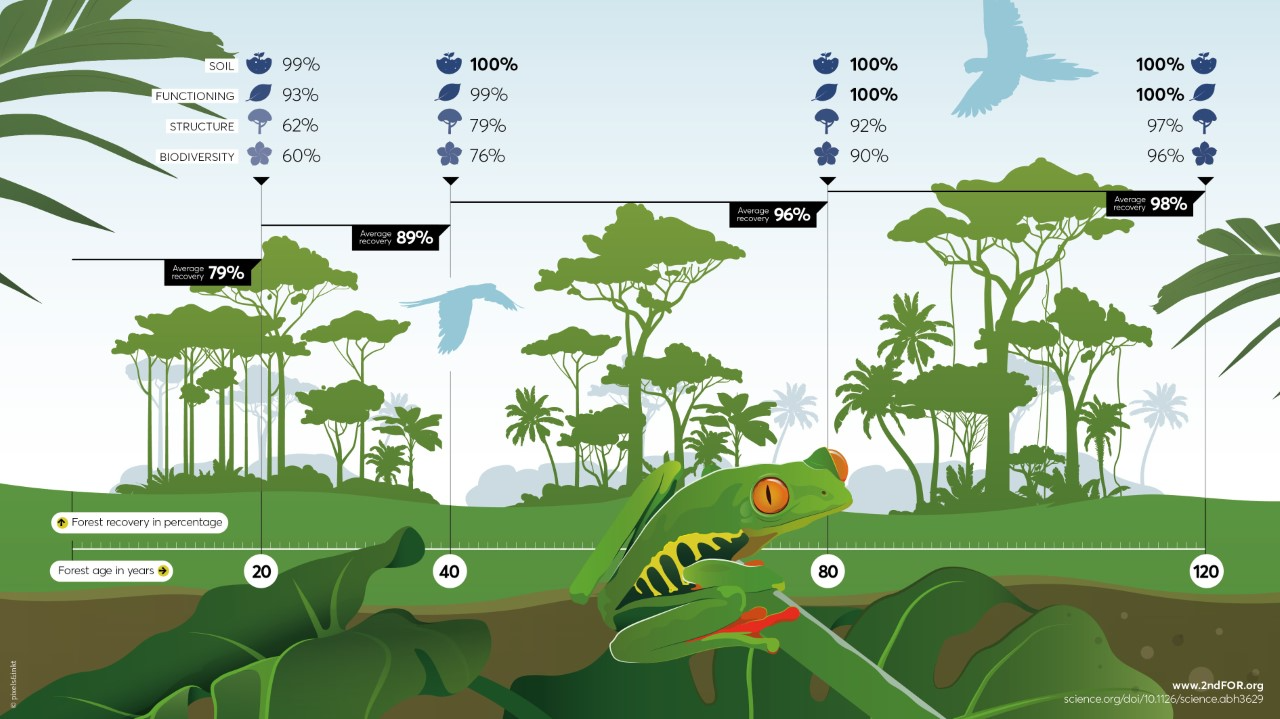Click here to read the Science article: https://www.science.org/doi/10.1126/science.abh3629
PRESS RELEASE:
Large short-term benefits of natural tropical forest restoration:
Regrowing forests attain after 20 years nearly 80% of the fertility, carbon storage, and tree diversity of old-growth forests
Tropical forests are converted at an alarming rate through deforestation, but also have the potential to regrow naturally on abandoned lands. A study published this week in Science shows that regrowing tropical forests recover surprisingly fast, and can attain after 20 years nearly 80% of the soil fertility, carbon storage and tree diversity of old-growth forests. The study concludes that natural regeneration is a low-cost, nature-based solution for climate change mitigation, biodiversity conservation, and ecosystem restoration.
The international team of tropical ecologists analysed how 12 forest attributes recover during the natural process of forest regeneration, and how their recovery is interrelated using 77 landscapes and > 2200 forest plots across tropical America and West Africa.
Lead author, Professor Poorter from Wageningen University, the Netherlands says: “While it is essential to actively protect old-growth forests and stop further deforestation, tropical forests have the potential to regrow naturally in already deforested areas on abandoned lands. These regrowing forests cover vast areas, and can contribute to local and global targets for ecosystem restoration. They provide global benefits for climate change mitigation and adaptation and biodiversity conservation, and many other services for local people, such as water, fuel, wood, and non-timber forest products”.
He continues “These forests recover surprisingly fast, indicating that there are large short-term benefits of natural tropical forest restoration. Yet, the speed of recovery differs strongly across forest attributes: Recovery to 90% of old-growth forest values is fastest for soil fertility (less than 10 years) and for plant functioning (less than 25 years), intermediate for structure and species diversity (25-60 years), and slowest for aboveground biomass and species composition (more than 120 years).”
Eben Broadbent, from The University of Florida says: “We assessed the recovery of forest attributes using a globally distributed network of secondary forest plots, and our key results found that maximum tree size, variation in forest structure, and tree species richness were strong indicators of forest recovery, and as they are easily measured in the field can be used to measure and monitor restoration success. New methods in remote sensing, including technology in the field, drone-based systems, such as our GatorEye platform, or satellites can now also be used to measure many of these parameters quickly and over large areas.”

Legend for Infographics on Multidimensional tropical forest recovery:
For more information, please contact:
Assistant Professor, Eben N. Broadbent, Spatial Ecology and Conservation (SPEC) Lab, School of Forest, Fisheries, and Geomatics Sciences, University of Florida, Gainesville, FL 32611 USA
Link to the article: science.org/doi/10.1126/science.abh3629
Find out more:
Website: www.2ndfor.org
twitter: @2ndFOR1
UN Decade on ecosystem restoration: click here.
Bonn Challenge to restore 350 million ha of forest by 2030: click here.
ERC-PANTROP project on biodiversity and recovery of forests in tropical landscapes: click here.

